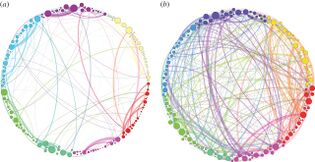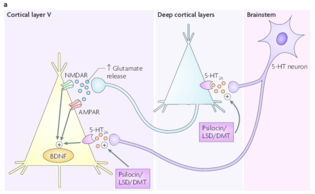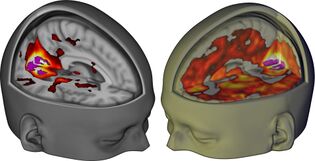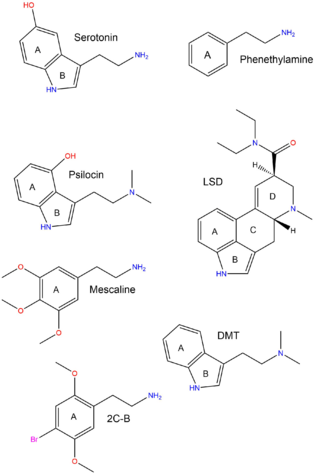Serotonergic psychedelic
Serotonergic psychedelics (also known as serotonergic hallucinogens) are a class of hallucinogenic substances with a method of action strongly tied to modifying the normal neurotransmission of serotonin in the central nervous system (CNS).
Serotonin, which is also referred to as 5-HT (from its chemical name 5-hydroxy-tryptamine), is a naturally-occurring monoamine neurotransmitter that is tied to functions including developmental, cardiovascular, gastrointestinal, and endocrine function, sensory perception, behaviors such as aggression, appetite, sex, sleep, mood, cognition, and memory, many of which have yet to be fully understood.[1]
Proposed method of action

The width of the links is proportional to their weight and the size of the nodes is proportional to their strength. Note that the proportion of heavy links between communities is much higher (and very different) in the psilocybin group, suggesting greater integration[2]

This glutamate release leads to an activation of AMPA and NMDA receptors on cortical pyramidal neurons. In addition, hallucinogens directly activate 5-HT2A receptors located on cortical pyramidal neurons. This activation is thought to ultimately lead to increased expression of brain-derived neurotrophic factor (BDNF).[3]

While the full mechanism of action is not understood, serotonergic psychedelics are known to exhibit partial agonist activity for various 5-HT receptors in a range of affinities and efficacies. As a result, they may be classified by their activity at different 5-HT sub-sites, such as 5-HT1A, 5-HT1B, 5-HT2A, etc.
Many serotonergic psychedelics, such as the family of tryptamines, have very strong structural similarities to serotonin itself. This partially explains the affinity they have for certain 5-HT sites. Most research suggests that the signature psychedelic effect is due to strong partial agonist activity at the 5-HT2A, and to a lesser extent, 5-HT2C and 5-HT1A receptors.[citation needed]
The cortico-striato-thalamo-cortical loops (also known as CSTC-loops) appear to be central to the function of psychedelics,[5] which are also regulated by the serotonergic system. These control loops connect brain areas like the frontal lobe, the striatum and the thalamus; they aggregate, process and forward internal and external information.
The disruption of the neurotransmitter balance causes these control loops to collapse overwhelmed, leading to the flooding of the frontal lobe with neuronal excitatory glutamate; internal and external stimuli as well as all kinds of non-conscious contents can freely move up to the cerebral cortex and appear as visions in consciousness.[6][7]
Furthermore, over-activation of the locus coeruleus and subsequent widespread norepinephrine secretion may occur, causing a perceived state of sensory transcendence and sometimes even intense spiritual or transpersonal experiences.
It is worth noting that selective serotonin reuptake inhibitors (a class of antidepressants including Paroxetine, Fluoxetine and Sertraline) can increase the dosage required for hallucinogenic effects in some people (based on anecdotal reports). Some users, however, have found this to be entirely untrue for them, so those who are using daily antidepressants should, at first, only attempt a common dosage.
Examples
Tryptamines
-
Base Tryptamines
-
Substituted Tryptamines
- 4-PO-DMT (Psilocybin)
- 4-HO-DMT (Psilocin)
- 4-HO-MET (Metocin)
- 4-HO-DET (Ethocin)
- 4-HO-MiPT (Miprocin)
- 4-HO-DiPT (Iprocin)
- 4-HO-MPT
- 4-HO-EPT
- 4-HO-DPT
- 4-AcO-DMT (Psilacetin)
- 4-AcO-MET (Metacetin, Azomet)
- 4-AcO-DET (Ethacetin)
- 4-AcO-MiPT (Mipracetin)
- 4-AcO-DiPT (Ipracetin)
- 4-AcO-MPT
- 4-AcO-EPT
- 4-AcO-DPT
- 5-HO-DMT (Bufotenin)
- 5-MeO-DMT
- 5-MeO-MiPT (Moxy)
- 5-MeO-DiPT (Foxy)
- 5-MeO-DALT
- 5-MeO-MALT
- Ibogaine
See also
External links
Literature
- Nichols, D. E. (2016). "Psychedelics". Pharmacological Reviews. 68 (2): 264–355. doi:10.1124/pr.115.011478. ISSN 1521-0081.
- Geyer, M.A.; Nichols, D.E.; Vollenweider, F.X. (2009). "Serotonin-Related Psychedelic Drugs": 731–738. doi:10.1016/B978-008045046-9.01160-8.
- Nichols, C. D., & Sanders-Bush, E. (2001). "Serotonin Receptor Signaling and Hallucinogenic Drug Action". Heffter Rev Psychedelic Res, 2, 73-79. https://web-beta.archive.org/web/20170110205041/https://heffter.org/docs/hrireview/02/chap5.pdf
- Halberstadt, Adam L. (2015). "Recent advances in the neuropsychopharmacology of serotonergic hallucinogens". Behavioural Brain Research. 277: 99–120. doi:10.1016/j.bbr.2014.07.016. ISSN 0166-4328.
- Beique, J.-C.; Imad, M.; Mladenovic, L.; Gingrich, J. A.; Andrade, R. (2007). "Mechanism of the 5-hydroxytryptamine 2A receptor-mediated facilitation of synaptic activity in prefrontal cortex". Proceedings of the National Academy of Sciences. 104 (23): 9870–9875. doi:10.1073/pnas.0700436104. ISSN 0027-8424.
- Winter, J.C; Fiorella, D.J; Timineri, D.M; Filipink, R.A; Helsley, S.E; Rabin, R.A (1999). "Serotonergic Receptor Subtypes and Hallucinogen-Induced Stimulus Control". Pharmacology Biochemistry and Behavior. 64 (2): 283–293. doi:10.1016/S0091-3057(99)00063-5. ISSN 0091-3057.
- Nichols, David E.; Nichols, Charles D. (2008). "Serotonin Receptors". Chemical Reviews. 108 (5): 1614–1641. doi:10.1021/cr078224o. ISSN 0009-2665.
- Canal, C. E., & Murnane, K. S. (2017). The serotonin 5-HT2C receptor and the non-addictive nature of classic hallucinogens. Journal of Psychopharmacology, 31(1), 127-143. https://doi.org/10.1177/0269881116677104
References
- ↑ David E. Nichols and Charles D. Nichols, Serotonin Receptors. Chemical Reviews. 2008. 108 (5), 1614-1641. https://doi.org/10.1021/cr078224o
- ↑ Petri, G., Expert, P., Turkheimer, F., Nutt, D., Hellyer, P. J., & Vaccarino, F. (2014). Homological scaffolds of brain functional networks, 14–18. https://doi.org/10.1098/rsif.2014.0873
- ↑ Vollenweider, F. X., & Kometer, M. (2010). The Neurobiology of Psychedelic Drugs: Implications for the Treatment of Mood Disorders. Nature Publishing Group, 11(9), 642–651. https://doi.org/10.1038/nrn2884
- ↑ Carhart-Harris, R. L., Muthukumaraswamy, S., Roseman, L., Kaelen, M., Droog, W., Murphy, K., … Nutt, D. J. (2016). Neural correlates of the LSD experience revealed by multimodal neuroimaging. Proceedings of the National Academy of Sciences. https://doi.org/10.1073/pnas.1518377113
- ↑ Taylor, S. B., Lewis, C. R., & Olive, M. F. (2013). The neurocircuitry of illicit psychostimulant addiction: acute and chronic effects in humans. Substance Abuse and Rehabilitation, 4, 29–43. https://doi.org/10.2147/SAR.S39684; [..] The overall output of the basal ganglia is predominantly via the thalamus, which then projects back to the PFC to form cortico-striatal-thalamo-cortical (CSTC) loops. [..]
- ↑ Vollenweider, F. X. (2001). Brain mechanisms of hallucinogens and entactogens. Dialogues in Clinical Neuroscience, 3(4), 265–79. Retrieved from https://doi.org/10.31887/DCNS.2001.3.4/fxvollenweider
- ↑ Edelrausch im Labor – Neuro Culture Lab (German)
